#I think the 18th century is very gender
Explore tagged Tumblr posts
Text
Rules: seven comfort films, seven people.

Interview With The Vampire (1994).
Belle (2014).
This beautiful fantastic (2017).
4 way tie between Amadeus (1984), Marie Antoinette (2006), Pirates of the Caribbean: curse of the black pearl (2003), and Barry Lyndon (1975).
Emma (1996 and 2020 versions).
Ram-Leela (2013).
Elvira, Mistress of the Dark (1988).
Borrowed from: @nordleuchten. 💕
Tagging: @tricornonthecob, @xxgothchatonxx, @malicious-compliance-esq, @no-depression-for-vampires, @rmstitanics, @iamthemaestro, & @musicboxmemories ~ if you want.
#meera.rambles#media#tag games#dash games#I think the 18th century is very gender#<— I’m still kicking Jefferson out a window
21 notes
·
View notes
Text
LIVEBLOG: Wakfu Season 4, Episode 4 [PART 2]

I wonder how long he's been standing there. Did he come an hour early? 20 minutes early? Just standing there, doing nothing...

Dios mio... la creatura!

Something very weird happened with the Eni queen/leader. In s2, her cape and hands were like this because she was sitting, in this season — it's just part of her design. Did nobody check this stuff? Am I going insane thinking this is an error? Did she look bad when her cape was down? What the fuck is happening?

Once again, something very silly is happening with Sufokia, if they have an empress and a king. My headcanon to fix it is "the king is a consort-king" or something.
(*sobs in Ankama, or, really, 89% of all media, not understanding that whoever marries the ruler of the nation is a [insert title]-consort, and does not have as much political power or the right of succession* *Hysterically convulses in "99% of all Queens were Queen-consorts, and the title itself, by default, usually means a consort. For this reason, female rulers (rare non-consort Queens who came to throne due to lack of male princes) typically named their husbands "Princes" and not "Kings", because the title king always implies a higher degree of power than a queen; therefore, it might be reasonable to assume, that in this fantasy setting, a Ruling Empress's husband might be called a king for this reason* *Foams at mouth because Ankama just forgot they mentioed Sufokia having a king and I'm trying to cope. badly*)
Also since I'm on this tangent already, YES, this means that Sadida rules of throne succession are:
1. extremely easy for outsiders to abuse (say what you will, but "the spouse inherits the throne" is a BADDD rule to combat conquest by foreign nations, there's a reason it was children or blood-relatives of the ruler, besides patriarchy/divine right of kings/whatever — the spouse is an outsider. All it takes is a princess, who is Wonderful at poisoning, being married off to a foreign nation and whoopsie-daisy, their country is now Her country, and therefore her Family's country),
2. it's unrealistic,
3. probably just bad writing for the sake of drama.
If you're curious why I know all this shit.......... I have a blorbo in a different fandom, and his entire thing is that he was married into a royal family and then tortured by his queen wife in a sort of gender-bent Henry VIII arrangement (except he was kept alive against his will and there was no divorce or church splits). God bless that blorbo for making me learn.

These Huppermages were repurposed from the movie concept art, btw.


I find it quite interesting, that Joris has the authority to be present here...
My personal theory/headcanon is that he is their mediator, and they just call him to their meetings so that, instead of yelling at each other and declaring wars, they can talk to him (and therefore, yell only at him and declare no wars).


Ugh, once again, I am not entirely fond of the English subs. First the translation error about the brotherhood of forgotten/tofu, and now they are making Joris say this spring chicken thing...
It doesn't fit his character and reads weird. Just leave it as "I'm not that young", like in the original. It's more fitting for Joris to speak in negative sentences ("I am not young") than in affirmative ones ("I am old") because he is not fond of stating direct facts about himself and his life... besides the fact that he's standing in front of multiple world leaders.


[kicks my legs cutely thinking about the fact that Joris, older than every king and queen in this place, and fully convinced of his excellence and wisdom and heroism, has been forced to bow down to them for his entire life despite hating at 90% of them for their political decision] I love his commitment to being the protagonist of an 18th century Russian novel about being doomed by the narrative.
Also, kinda wild. You'd think that during Ogrest's chaos they'd— actually I think everyone was too dead to hold meetings during that, nvm.




I wonder what they would do, if the maker of the eyes wouldn't reply. Just stand there? Or is this speech more of a formality — something he always says, in the lead-up to the meeting?
(I am once again reminding you, this blog is LITERALLY about overthinking crepinjurgen lore! Ankama gave no shit while writing this. I'm just doing this for fun.)

He's so unimpressed. Probably still trying to gauge what the fuck is going on.


THE LITTLE SMILE— he's trying to suppress it so hard in the first screenshot here. He's probably glad that Yugo seems to be in good spirits about what's happening, even if he himself is still quite worried.

His expression here is a beautiful mix of "PLEASE DON'T FUCK THIS UP" and "it is a canon event, I cannot intervene"

Literally, Joris's expressions at this moment should be analyzed frame by frame. You can feel the desperation. He now understands that there is a high possibility they are fucked. Because his bestie (who is always right) is an impulsive 20-something year old boy who knows nothing about politics or what people can do, and his mom is a god, and the leaders of the world aren't going to like whatever the fuck is going on, and he KNOWS what they might do, and what might happen, and oh god oh fuck oh god oh fuck—
"Yugo :) perhaps you shuoild :) um. :) ease them into it. :).... :("
He's trying to keep smiling, so hard. It's crazy.

Joris has lived through the huppermage genocide. He knows people don't need that much of a reason to begin killing. He understands precisely just how fragile the position that Yugo and his people are in. He understands his own place in the pecking order, too — he isn't going to act like Yugo's friend if these people are watching.
And neither Yugo, not any other Eliatrope is able to understand this. There are cruelties in this world that they are fundamentally unable to grasp without having truly been seeped in it before.


Like, what is he even to do here, to make Yugo understand how bad the situation is. All he can do is stand there looking haunted, while receiving unprecedented amounts of psychic damage.


If I was Joris at this point, I would simply pull out a flask of whiskey and a cigarette. The political situation has now gone completely unfixable. There is no going back, now that she has said these two lines.
Someone native to the World of Twelve and old enough to understand politics would know how bad this sounds. But to her, these are good things. Of course they are, since she knows what is good and what isn't, and everyone in her world has always accepted those things as good.
Basically: the conflict between WoT and Eliatropes is that a nation of people from a world of teletubbies-level conflict, — with no bigotry or nations or poverty or hunger or theft or inequality, or ulterior motives, — has been added to a "game of thrones" type society with no explanation. And now they are all forced to try and understand one another.

If I was Joris at this moment, I would simply shoot myself in the temple with a gun. If things were bad before, they are horrible now. She is talking to world leaders as her children. It might have been alright even with Eliatropes, but these people aren't Eliatropes.


DO I EVEN NEED TO COMMENT ON HOW BAD THIS IS? IN A WORLD WHERE COLONIALISM, RACISM, SUBJUGATION, AND SLAVERY ARE REAL? IS SHE ON CRACK?
I would give anythign to see Joris's expressions as she's saying these things. I think he should be trembling. Staring vacantly into space.

To someone from a world of violence, a world with "no violence" seems like a world where violence is hidden, and enacted to stop them from voicing their disagreement with the status quo.
Tot has described this as a sort of conflict between the modern world approaches to society — and named China and America as examples of what he was inspired by, while writing Eliatrope.
I will not get into detail on my feelings on it (China is often extremely criticized in the west for things every country in the world does due to racism)
But this might point us towards the fact that the world of Eliatropes wasn't as free of conflict as the show portrays it to be, and it was, in fact, Just A Society, with all that entails. In which case, things get morally morally gray... might explain why, in the earlier drafts of the season, she was meant to be the main antagonist — and why it was decided against.
(Is that maybe why Qilby is so embittered — his experiences were silenced, and he was made to suck it up, only confiding in Shinonome? She does constantly shut up Yugo and Qilby, not letting them speak up about their grudges against each other to keep the peace— [I am quickly silenced by tangent police])
58 notes
·
View notes
Note
i have a very different gender presentation to you generally but one thing that's transition goals for me is i hope when i bald it will be like you. don't see many balding people that still have the non-balding parts long so even tho im happy w the prospect of balding and fairly confident i will like how i look it's rly nice to actually see someone else doing it n looking swag
Thank you! I don't think my non-bald parts are particularly long, and I do need a trim, but yeah I wouldn't want to cut it super short. Nice to have some mad scientist floof on the sides.
I thought I'd be really upset about losing my hair, but then it started getting really thin on top and I just went "ehh, whatever. Worth it!!!"
I would absolutely still have it at shoulder length if it hadn't done that though.
The one thing that's kind of annoying is I can't do 18th century hairstyles with it anymore, and I don't have any wigs and haven't tried wig styling yet, so I haven't done a proper full historical look in a few years. Someday. When I eventually get around to making that extravagant 1720's suit I will have to tackle wig styling.
132 notes
·
View notes
Note
Can I get a headcanon of the Pomefiore trio as vampires and Riddle as a Ghost Groom falling in love with y/n please? Gender neutral please and thank you!
I’m just gonna assume that the reader is human for this
Vampire!Pomefiore Trio and Ghost Groom!Riddle + falling in love with reader!
Vil Schoenhiet

Vil rarely goes out into the towns, there’s too many people and he would most definitely be noticed by someone. It’s fairly difficult being a famous vampire, either people flock to try to see you or people come for him with pitchforks and torches like it’s still the 18th century.
That doesn’t stop him from coming in from time to time. Which led to him bumping into you while you were taking care of a last minute errand.
At first, he was intrigued as to why you didn’t run away in fear when you saw who was in front of you. And when you looked directly into his eyes, he only grew more interested in learning more about you.
He started to come to the town more, and strangely enough he started to see you around more as well. Although his mind told him that you just happened to have a couple of errands to run, his heart hoped that you truly did want to see him.
“Oh hello there, I was hoping to run into you again. Would you allow me to walk with you to your next errand? I would love to talk with you a little more.”
Rook Hunt

Rook has always been one to watch and observe than immediately get involved right away. So when you catch his eye on a stormy night, he intended to do just that.
What he didn’t intend was for you to realize he was “observing” being a creep and started to ask him questions. Rook is a lot of things, but he isn’t a liar, he outright tells you that he’s a vampire when you ask.
He’ll be more surprised if you don’t run away screaming profanities and curses at him. Delighted, but still very surprised.
He’d love it if you’d walk with him during the nights, he rarely gets to speak with people other than vampires. He loves hearing what you think of life in the daylight.
“Oh mon ami, I adore it when you speak your mind! Please allow me to be in your presence once again soon.”
Epel Felmier

Epel never saw that many humans from where he lived. They often told stories of a “haunted farm” where the animals were fed and crops were grown without a person watching them.
These stories of course, were just ways to keep people from going to the Felmier farm. There was, as always, people who tried to get in for one reason or another.
One of those people was you. Usually Epel would just “take care” of any intruders but he was told to “have some more dignity and self-respect” by one of the older vampires so he’s been forced to trying to do that.
When he came up to try and scare you off, he noticed that you didn’t run or scream in terror. Instead you asked why he was alone on a farm. You were also petting one of his horses but he chose to ignore that.
“Oh y’know…just running the farm by myself. I could let you look around some more if you’d like.”
Riddle Rosehearts

Riddle never thought he’d be able to love again. You know, because of the whole “Being left at the altar and then forced to watch others get the happy ending that you’ve always wanted” thing.
That was until he saw you. He watched as you roamed the chapel that he is frequently spotted at.
He knew that he’d just be a creep to continue watching you without at least formally introducing himself. Unsurprisingly, you were terrified when he appeared a few feet beside you.
After that initial shock, you two became very well acquainted and the two of you started to see each other more often. Although he once detested the idea of falling in love again, he figures it won’t be so bad if it was with you.
“I haven’t felt this alive since- I can’t even remember when. I suppose it may have something to do with you.”
#twisted wonderland imagines#twisted wonderland x reader#twst x reader#twst imagines#vil schoenheit#twst vil#vil schoenheit x reader#rook hunt#twst rook#rook hunt x reader#twst epel#epel felmier#epel felmier x reader#twst riddle#riddle rosehearts#riddle rosehearts x reader
622 notes
·
View notes
Note
Hi, while looking through extant garments in a museum collection for reference for a school project, I found several garments of different designs that were all labelled as "binder" without any other context or explanation. Obviously my first thought was the kind of binder I use, especially for the first one that looks elasticated, but I have to assume they're for something else like gynecomastia or compression..? Do you know happen to know anything about them?
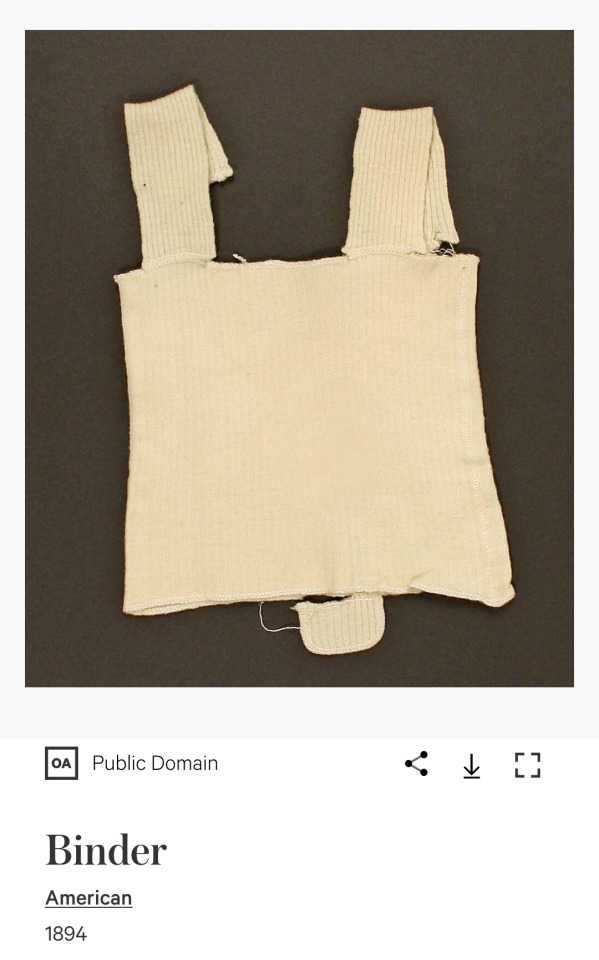

This is interesting!
They could actually be the types of binders you use. I immediately thought of 19th century male impersonators - female (?) actors who specialized in male roles in Vaudeville and other similar forms of theater, in which drag was integral part of, and would also have their own one man impersonation comedy and music shows and male stage personas. Basically they were drag kings. (Similarly female impersonators, basically drag queens, were also quite popular.) They were known to bind their chest, and other actors, who didn't necessarily do the impersonation shows, but played male roles on stage, would also often bind their chest for their performance. Here's for example two successful male impersonators, British Vesta Tilley (first picture) and American Ella Westner (second picture).

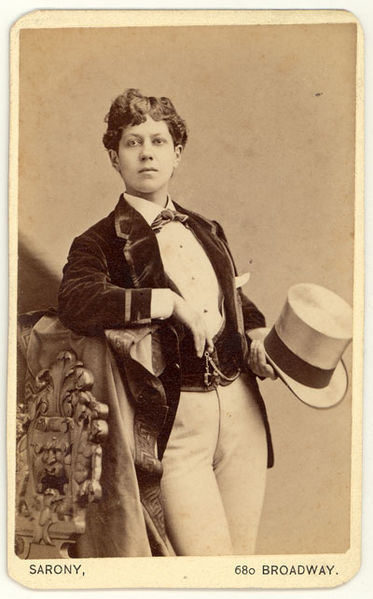

Queer women and trans masc people, who dressed in masculine clothing, (which was pretty common) also sometimes bound their chests, but unsurprisingly that was not exactly celebrated like drag performances were, so there weren't binders made for queer people specifically. I'm guessing they either made their own binders or used binders made for actors. Often those actors were the same people as those queer people, since drag performance was one of the few socially acceptable ways to fuck around with gender. Not all of them were queer, Vesta Tilley looks excellently queer in her drag, but outside stage she was respectable member of high society and very supportive of her husband who became conservative member of parliament (after she had retired). And I think we can easily imagine what kind of political opinions about queer people she was supporting when he was conservative in the context of 1923 Britain. But many of them were known to be queer, like Ella Westner, who eloped to Paris with a very interesting woman, Josie Mansfield (pictured in the last photo above), who was mistress to an infamous scammer and the man who murdered him. Westner was also buried in men's clothing by their own request.
I couldn't find pictures though what did the binders used for chest binding looked like, so I decided to look into what kind of other binders were used in the era. I think the first binder or perhaps both of them could be baby/infant binders (first two pictures below). Apparently people in Victorian era (and in 18th century) believed that chilled abdomen could cause cholera and I guess other bowel issues, so they treated cholera and tried to prevent it by wearing binders and belts (last picture), which could be also made from flannel or wool knit for extra warmth. And babies are quite vulnerable to bowel issues and cholera, so they made binders for babies too. I've seen many different types for these (for both baby and adult use) with some of them like cloth wraps, and some of them kinda corset looking though not corset shaped. If the binders you found were indeed for abdomen warming purposes, I'm sure they are for babies, since those for adults would be so low there definitely wouldn't be shoulder straps like that. The proportions on the first binder especially seem to me fitting for a baby, like the straps feel a bit too wide for adult scale. The second one is harder to guess, it could be a baby binder, but it seems to have boning in the middle, which would make maybe more sense in a chest binder?
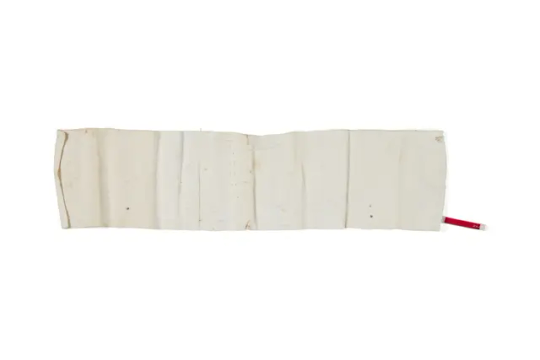


But yeah Victorian medicine continues to be... interesting.
#extant garment#historical fashion#fashion history#history#victorian fashion#queer history#undergarments#historical clothing#dress history#historical binder#photography#answers
98 notes
·
View notes
Text
Thanks for tagging me @little-desi-historian! ❤️
YES, all of this takes me back to something I wanted to touch a lot more on in my original post when it comes to the historical male image, Percy, Lestat, and Matadors; because it truly does link back to how AMC is playing with dandyism and society's expectations about effeminate men.
Dandyism is a form of resistance culture. As I've said before, Lestat flouts gender norms because HE CAN do whatever he wants & get away with it. His androgyny's on a different level: effeminate or masculine, he's still a vampire, a SUPERnatural creature elevated beyond the bounds of social mores that determine what men & women could or SHOULD act/dress like. MANY people across social media have pointed to Lestat's limp wrists, long blonde "Barbie" hair and ESPECIALLY him dressing in drag in Ep7 as proof that he's the "wife/mother/woman/femme fatale" in Lousta's relationship, and THEN claim its either gender essentialism or homophobic/racist to say Louis is CANONICALLY female-coded one in BOTH the books and show (as AR said so). But no, Lestat in drag was a power move, because he doesn't care what anyone thinks/says/does--he'll just eat them. Mockingly eating the baby in a dress was a deliberate bastardization of motherhood/womanhood. Louis is called every homophobic name in the book by those expecting the black man to just take being insulted, but MARQUIS de Lioncourt DEMANDS being crowned KING of Mardi Gras, Krewe of Raj, & he'll show you exactly what he thinks about your silly homophobic hypocritical human society: You're just "the MEAT," let them eat KING Cake--you're his FOOD. Eff y'all, I'm dressed to KILL you, & laugh doing it.
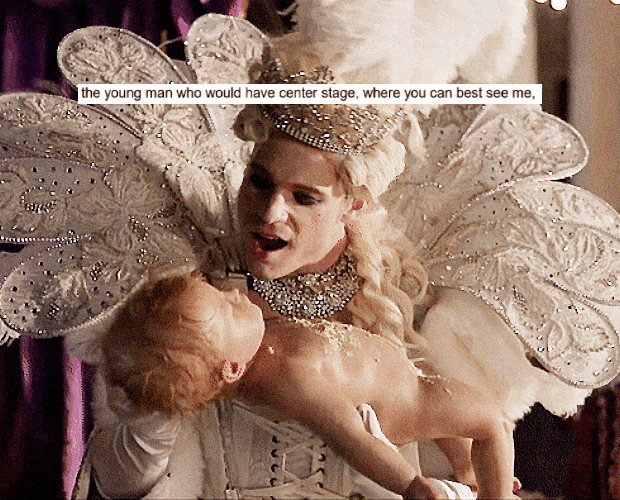
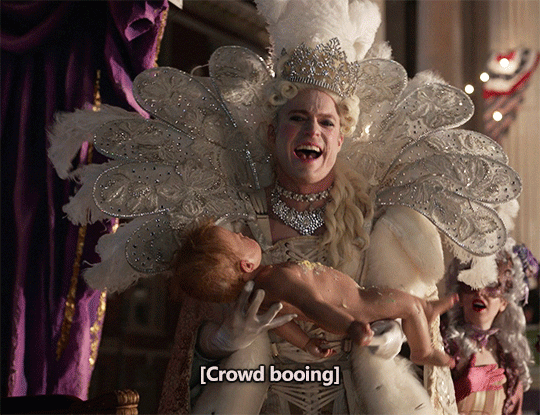
Lestat's behavior is not only derived from the time period he was born & raised in (the Rococo era of so-called "effeminate" high class dandies--a la Percy Blakeney, etc). Lestat is the embodiment of PRIVILEGE: a powerful rich white male vampire, who leans into being foreign/French White to excuse anything he does that people find strange/off/unnatural/dangerous--all the red flags. 🚩🚩🚩
And red flags brings me directly back to matadors/toreros.

@toscrollperchancetomeme
😂 TYSM! Sam Reid dropped so many juicy deets; I couldn't resist! There's so much depth to the Matador outfit, beyond the gendered aspect of bullfighting that I discussed before. Let's go back to what Sam said about Lestat, and delve deeper into matadors:

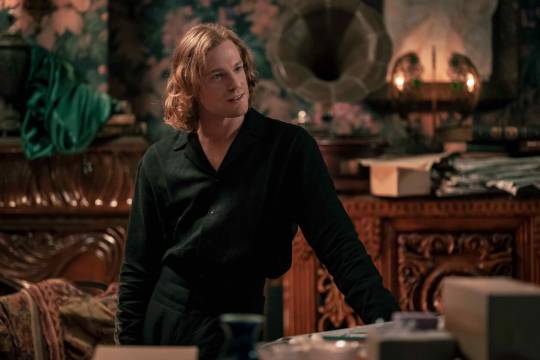
The most iconic apparel worn by toreros ("bullfighters") / matador de toros ("killer of bulls") in Spanish bullfighting is the Traje de Luces, the "Suit of Lights." The colors are usually bright & vivid, as part of the showmanship & pizzazz. Darker palettes are less common, as shiny sequins (the luces/lights) became part of the standard fit.


However, Lestat's all-black Matador outfit from what Sam called the "villain sequence" in Ep5 seems to be loosely following the style of a different but very closely related outfit, the Traje Campero "Rural/Countryside Suit" aka Traje Corto ("Short Suit").
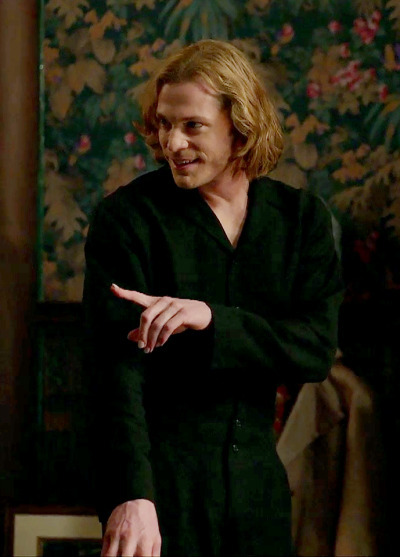
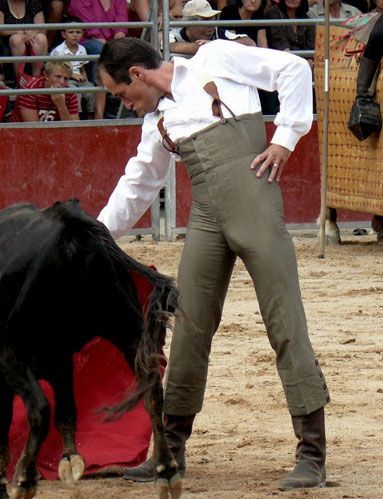
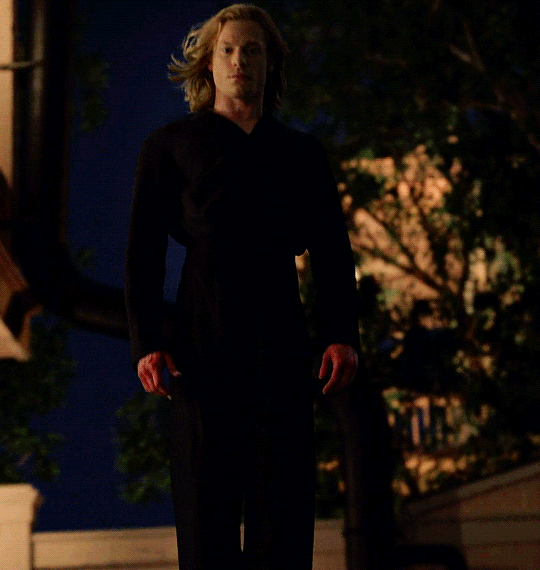
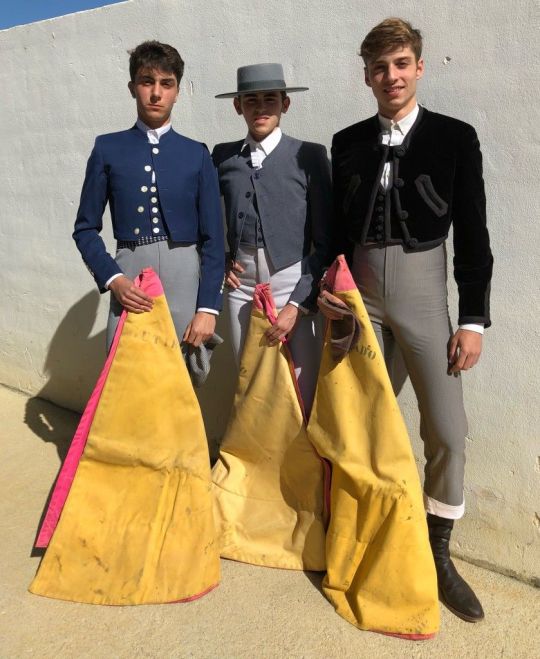
(These costumes are typically worn during ceremonial parades and a very specific festival I'll get back to in a moment, cuz it's important.) Unlike the Suit of Light's sequins & silk, the Rural Suit is made of suede, leather, or velvet, in dark muted colors. The pants can be light or dark, striped & patterned, with or without chaps (also found in gentleman's uniforms of military officers and cowboys).
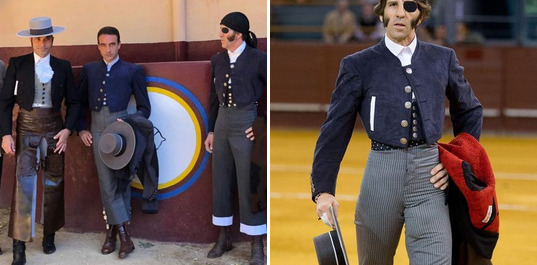
The trajes originated from "the flamboyant costumes of the 18th-century dandies and showmen involved in bullfighting, which later became exclusive to the bullfighting ritual." (Wikipedia)
The ancestor of both trajes (luces/campero) is traditional 17th-19th century Andalusian clothing (Andalusia being the home of Spanish bullfighting), closely associated with a very particular type of masculine dandyism. (The campero/corto is also the costume worn by Andalusian male flamenco dancers.)
"Before the 17th century the profession of bullfighting did not exist as such, and the fighters did not wear luxurious & shiny trajes de luces, but instead normal clothes of the time according to the social class to which the bullfighter belonged. The first bullfighter trajes de toreros appeared in the 17th century, when professional bullfighters from Navarre & Andalusia wore characteristic garments with their gangs to participate in performances and thus differentiate themselves from other bullfighter bands." (translated/truncated from Spanish website)
In the mid-1700s, Francisco Romero revolutionized professional bullfighting by establishing the first matadors who fought on foot, heroically fighting the bull face to face with swords & the muleta (iconic red flag) in a dance-like performance, dressed in a suede/velvet coleto (jacket), a precursor to the traje campero. Romero (from a carpenter family) wanted to show off & stand out from the nobility, and changed the game entirely, through a form of social resistance-turned-innovation.
"At that time, bullfighting on horseback was more important, which was considered a sport and not a show. Bullfighting on foot was not yet widely recognized." (translated from Spanish website)
Bull-killing on horseback was practiced by Spanish noblemen, attended by lower class assistants on foot. Romero was the first to make on-foot matadors the stars of what was increasingly becoming a dandified show/performance/dance. Matador Joaquin "Costillares" Rodríguez introduced even more showmanship, competing against Francisco Romero's grandson Pedro Romero (famously painted by Goya--bottom right).
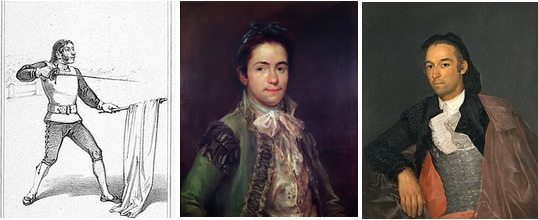
For his matches, Costillares (middle) dressed in flashy silks, threaded in shiny silver braiding; the precursor to modern traje de luces. Like Francisco Romero (left), Costillares wanted to show off & stand out; and revolutionized the male image of the bullfighter through clothes.
In 18th-19th century Andalusian Spain there were 2 types of dandy: the French-imported upperclass petimetre (effeminate dandy), and the indigenous working class majo (masculine/macho dandy).
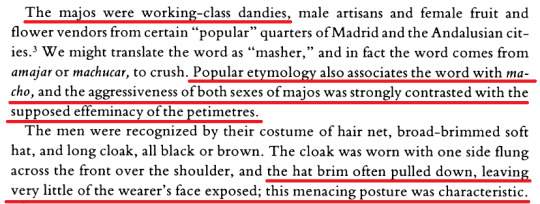
Noyes, Dorothy. “La Maja Vestida: Dress as Resistance to Enlightenment in Late-18th-Century Madrid.” The Journal of American Folklore 111, no. 440 (1998): 197–217. https://www.jstor.org/stable/541941
The majo, like many dandies, became the peak of Andalusian fashion, across all social classes; and torero/matador outfits weren't the only ones to take cues from them:

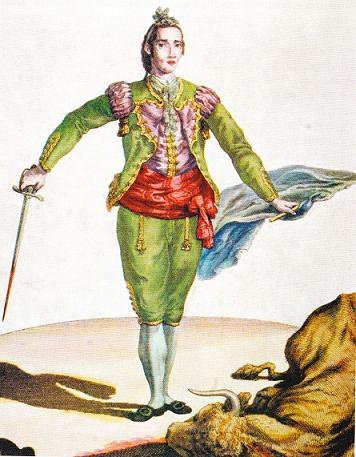
18th-19th century majos "distinguished themselves by their elaborate outfits and sense of style in dress and manners, as well as by their cheeky behavior. The majos outfits were exaggerations of traditional Spanish dress. The style stood in strong contrast to the French styles affected by many of the Spanish elite under the influence of the Enlightenment. Majos were known to pick fights with those they saw as afrancesados ("Frenchified" – fops)." (Wikipedia)
The majos' flamboyant/cheeky/saucy/exaggerated behavior was aggressively masculine; a lower/working class resistance to social mores imposed on them by (foreign) elites, whom they saw as more feminine, and FOUGHT against, to reaffirm their masculinity. These dandies were violent, brazen non-conformists; as beautiful & stylish as they were dangerous. And matadors/toreros knew that the bullfight was the perfect arena to exemplify the spirit of the majos through the dandified performance art/sport of killing bulls--a universal cultural symbol of masculine prowess & strength. Spanish bullfighting used to belong solely to the aristocratic equestrian sphere. Lowly pages/assistants like Francisco Romero (dressed in the precursor to the Rural/Countryside Suit), were the first to buck the system by killing bulls on foot--he likely didn't own a horse. The Romeros were from a carpenter family. Costillares was the son of a butcher. But through bullfighting they gained social status and became icons of masculinity--and dandies.
Lestat--the nouveau riche son of a poor country marquis--insists on being all the beautiful things he is without apology: masculine & effeminate alike. But like I said, it was no coincidence that Carol likened Lestat's Ep5 villain outfit with matadors--he's fighting Louis for dominance in their household, and reaffirming his place at the top of their very gendered social hierarchy, as a warning to BOTH "the housewife" AND "the prodigal daughter" he feels are threatening his authority as their Maker, so he defeats them BOTH.
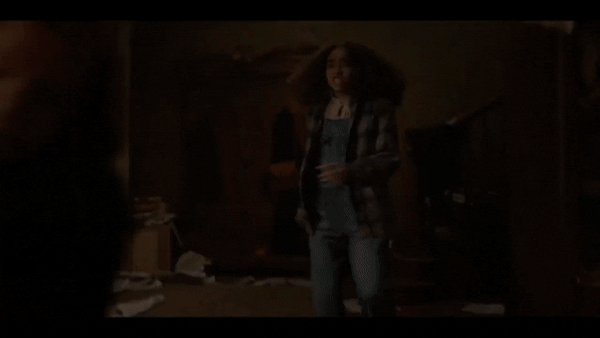
Carol Cutshall initially designed Lestat's matador pants as pajamas--loungewear. (Lestat's CASUAL & comfortable in his ability to KILL--matador means "Killer" in Spanish--and remember what I said about Louis & Claudia being put on the same parallel level in Ep5, when Claudia's attacked by "Killer" aka Bruce.) Sam said Carol made several versions of the pants; and yup, they're foreshadowed in Ep5 when Lestat first starts arguing about Louis' depression, then they pop up again in Ep7 during the Murder Plot--two instances @dwreader brilliantly linked Lestat (& Stanley Kowalski) wearing wifebeaters. (Listen, Carol, I just wanna talk.... 😅🔫)


And here's my last points about Lestat's matador outfit. First there's the irony of Lestat (who grew up poor in rural France) wearing the something very similar to the matador/torero's Rural Suit, traje campero (aka Short Suit (traje corto)). But what's more interesting is that that type of Short/Rural Suit is usually only worn during special festivals called the Tienta ("trials"), not the regular corrida ("bullfights").

These Tienta are trials for young and immature bulls to be tested in the ring, to see if they're fit for breeding/fighting. 🤯 FLEDGLINGS. And who's Lestat's young bull? "Built-like-a-bird" Claudia. Who's the immature bull? The "biggest rat eater of them all," the under-developed "botched" vampire Louis. During these trials, veteran matadors can show off their skills; and novice bullfighters are shown the ropes and prove themselves. Like I said: the matador wins again.
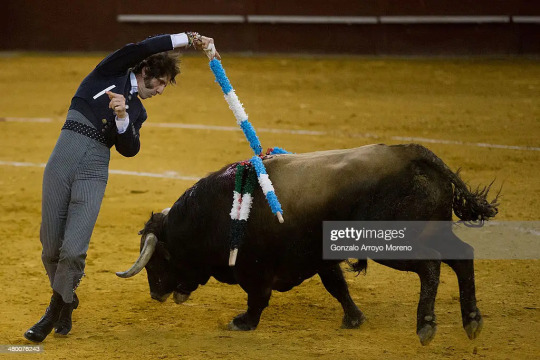
God, even the way Lestat dragged Louis' bloody body out of the courtyard by the jaw/neck resembles the way the defeated bull--bled out & stabbed in the neck--is dragged by the neck out of the ring.

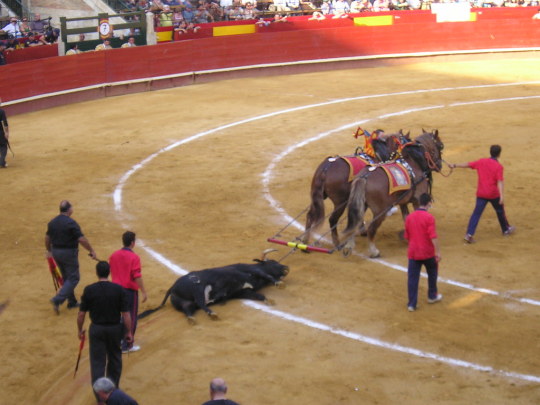
And remember what I said about Lestat and FOOD. Cuz what happens to the bulls after the matadors kill them? They're sent to the slaughterhouse to be butchered for FOOD. People EAT the bulls.


So yeah, my whole point in this post and my first one is not to sleep on guys like Lestat, Percy--or even other famous dandies like Valmont from Dangerous Liasions/Cruel Intentions (mentioned by both @little-desi-historian and @dwreader)--just because they're effeminate--especially when they're emulating mannerisms from a time period where the model of what made a fashionable gentlemen/good breeding/elite society did NOT match modern expectations about gender. People are getting distracted by Lestat's yaasified manner, not what the show itself is signalling through the relationships he has with others.
This show is deliberately painting Lestat as a villain through Louis' & Claudia's perspectives, as they were the ones who suffered under his Reign of Terror. The symbolism behind the matador-inspired costume used in Ep5 reflected gendered social hierarchies embedded within bullfighting culture (in Spain, women only started being allowed to fight in the 19th-20th centuries). Dressed in clothes resembling that of a matador, Lestat beating & defeating Louis mirrored the defeat of the emasculated bull, and the reification of the victor's masculine prowess at the top of the foodchain.
#the vampire lestat#male fashion#fashion history#gender inequality#read a dang history book#operation matador#iwtv tvc metas#lestat de lioncourt
390 notes
·
View notes
Text
There is evidence that Thomas Jefferson may have been queer
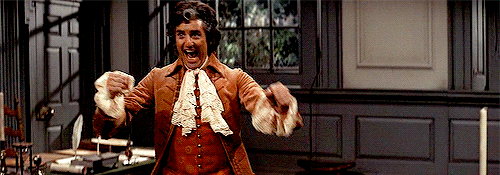
Over the weekend I went to a history conference as one does. I was looking at the program and one of the lectures caught my eye. I was like "wait is that lecture what I think it is because if it is that would be awesome" so I went. It WAS awesome. The lecture was by an archivist who is doing a project on Jefferson's writings. Her background qualifies her to analyze 18th-century letters.
So basically she was reading books because that's what librarians do and the quotation “No body knows how much I wish to be with you” was very obviously right there. She realized that no one has done research on this before and decided to be the one to do it. The lecturer is still in progress if analyzing Jefferson’s papers and library.
To be clear, this lecture states that there is not enough evidence to definitively say Jefferson was queer, but just evidence that seems to be queer. The evidence is clearly homosocial, but anything beyond that can only be inferred.
my notes (my apologies if they are confusing at any point)
hahhahehheheh Jefferson: “No body knows how much I wish to be with you” Jefferson and Page and the Intimacy of Encryption
Same talk given to LGBTQ+ group
Coded letters to John Page
Page lives at Roseburg! Jefferson went there a lot
Scared people would find his letters so be encrypted
But he liked it like it was a game
Send real info but also bestie stuff
Impossible to determine Jefferson as queer but this is just fun
How do you define letters as queer or no?
Gender switch, Greek letters, codes
Coding citizenship, gender, sexuality
Homosocial bonds develop when yapping about exchange of women
Jefferson dirty enslaver grrrr
Sally Hemmings :(
Jefferson thought libraries, newspaper, education were essential to American nationality
Letters technology of collective fantasy
Lost history of cryptology
Jefferson father of American cryptology
Homosociality and stuff
Gay? 🤨 I mean he read ancient gay stuff
Trafficking women part of this (like using wives/daughters to connect families) :(
Connect families
Cedric mother of queer theory
Tools for examining must be subtle and definitive
Variable and political
Emerging subject categories in Jefferson’s writings
William Bendamen shows that Jefferson would be aware of queerness from what is in his library
Gay porn in 18th century WHAT
he owns gay porn caught in 4k
Lots of this is encoded, destroyed, difference in language & culture
Buggery laws
THE LETTERS to Page. 20 January 1763
Friends from youth to Page’s death in 1808
Letter from Shadwell. Jefferson is around 20.
“Why can you and I not be married, too?”
The commas, references, tenses, Latin is hard to attribute
Friendship or queer is unknown
Reference to laws of human nature. Early scientific musings of relationships
Elusiveness of understanding may be intentional.
Life together supported by letter 6 months later
Rebecca Burwell. Belinda
Plans to propose to her and writes to Page from Williamsburg “Devilsburg”
Refers to Belinda as “he”
Rejected by her
If it worked he and Page related by marriage between Burwells
Written like business transaction. (trafficking of women between men)
Many homosocial letters talk about trafficking of women
Jefferson thought his letter was interception and is super paranoid
Ask Page if he found this
Jefferson freaking out and asks him to being better code. I’m going to send you this.
Develops wheel cipher
3 months later Jefferson finds out Rebecca married to something else
Page marries. Jefferson moves to Monticello, marries Martha
Last letter
I can die with sweet resignation after reading your letter
Letters from Page lost in Shadwell fire
Page and Jefferson letters are ones between young men and are representative of such
Jefferson uncomfortable with women. Kinda misogyny but he’s so confusing so it’s hard to classify
Categorizing Jefferson but it’s all connected
This is technique to secure bonds among wealthy planter elite. College friends! This is before Revolution and stuff
There is so much to cover
Jefferson weird and paper expensive. He knows papers are to be shared and he decided NUH UH.
Jefferson morals vs action
Notes on Virginia. RACIST
Black writers at bottom in notes and in library
Boooo he’s a loser
Kicks off institutionalization in America
Jefferson isn’t the only one to code
Anne Lister codes. Puts lesbian letters in crypt.
This info puts my post from a year ago about Martha Jefferson’s epitaph into context, actually! The Greek reference and gender swapping is just Thomas’s thing with people closest to him. I wonder how many others got this treatment...Jefferson and gender is really something else, like bro can't interact with women yet swaps their gender in writing. What's going on in his silly autistic (probably) brain? Referencing mythology is also pretty cool like what a nerd using ancient Greek analogies.
I always found his coding interesting but just haven’t researched it. This new research is special to me because @asica-black and I used to discuss Jefferson’s coding and think “hey do you think these were coded and he worried that people would accuse him of buggery?” and answer is most likely yes!
So yeah it seems like Jefferson had a boyfriend.
#btw buggery is 18-century for gay#bro has been added to my list of “most likely queer presidents” along with Buchanan Lincoln and JFK but there are most likely more#asica-black#hehe I called him after the conference to tell him the news#this is 'cold in my professions' (jefferson's version)#amrev#thomas jefferson#queer history#this is real research#historical scholarship#founding fathers#my notes
26 notes
·
View notes
Text
Nell's Shirt Recreation
Part 1 | Part 2 | Part 3 | Part 4 | Part 5
Alright, being a Renegade Nell fan and a historical fashion fan has unsurprisingly led me down the rabbit hole of their costuming. So, I'm recreating Nell's shirt best I can, cause gender envy :D
I'm also gonna try document my progress as I love to infodump and a few people on the renegade nell discord server have asked me to lmao. This post is gonna be about planning, drafting and cutting!
Planning:
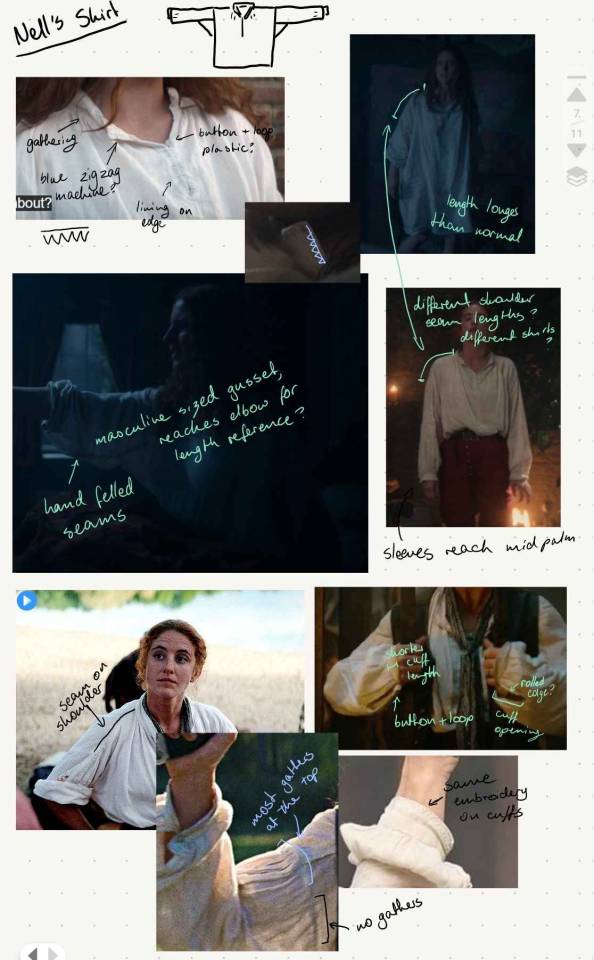
Above is my collection of screenshots (and gifs u can find if you search #sewing reference on my blog) from a rewatch of the show, with notes about construction details. I am so sorry about my handwriting, but if anyone is curious about anything they can't read please ask and I will happily provide.
The rundown though, is that it's a classic 18th century men's shirt, which you can find countless tutorials for if you want to make one that isn't so specifically Nell's.
There are a number of key details to note that are specific to this shirt however. The sizing of the shirt is a bit abnormal to the brief research I've done, with Nell's gussets (the triangle under the arm that allows movement) being a bit larger than what's to be expected, as well as the length being extremely long compared to other men's shirts. Eg:

(Credit indigomood for the gif, my phone couldn't handle searching for it in gifs so I had to download it)
Which, would make sense for a shirt she's taken from her late husband, but the sleeves are so fitted perfectly to her arm length, that I'm gonna just chalk these up as a mix of design choices for the comfort of Lousia when filming and giving the illusion of an oversized shirt.
Also, the cuffs and collar have a simple embroidery edging to them which I love. They have most likely been done on a modern machine, but we can cut Tom Pye some slack with the rest of the amazing work he's done. It looks like a zigzag stitch, with a straight stitch running on the side closest to the edge.
Also also, if anyone has seen Bernadette Banners pirate shirt tutorial, the sleeves and collar have less fabric and as a result less gathering. It's also mostly situated at the very tops of the shoulder, rather than all around the arms eye.
Alrightly onto the pattern drafting:
The Pattern:
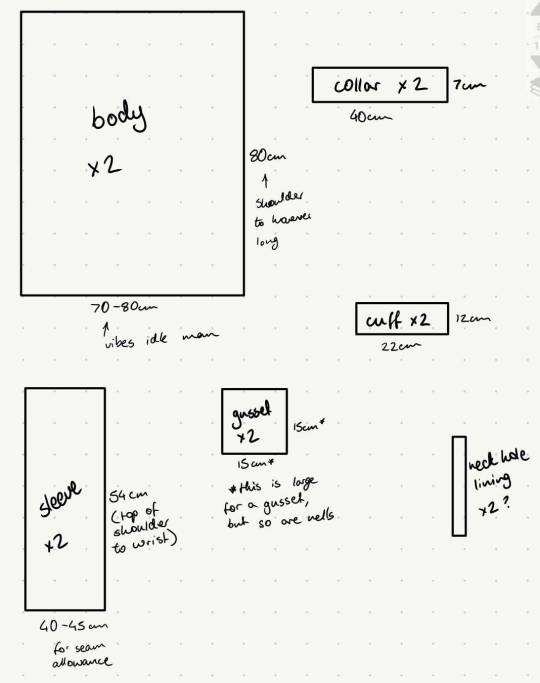

The first image is a not-to-scale sketch up of all the pattern pieces, with my estimation of measurements (with about 1cm seam allowance idk I learnt to sew without a sewing machine and this project isn't very fussy) for each piece, as well as some short notes for how I got some of the measurements. The second image is just a guide/plan of how to lay each piece out on my fabric with minimal waste, and will be different for each person if yall attempt this.
I'm ngl, I snatched Bernadette's pattern as a base, cause I've made that shirt before. The measurements also are a weird mix of the guides given in Bernadette's video, a great informative comment on the video by musikkfreaken342, and a general taking measurements of my own body (which is a similar body type to Nell's) and seeing how they compare to the photo references. I wish I could give more guidance here but I'm ngl I went based on vibes for most of this.
*Note: despite how long Nell's shirt appears to be in that Billy intro scene, I'm going to run on the assumption that the length was for actor comfort, and will be cutting mine shorter.
Also, ignore the neck slit lining/reinforcement for now. Idk how I'm doing that yet... so yeah.
Alright!! Moving onto actually cutting out the fabric!
Cutting the Fabric:
Historically these shirts are made from linen (and sometimes cotton I think?). Great material: looks great, breaths easy, whips sweat away from the skin to protect your outer layers.
I've personally chosen a lightweight linen/rayon blend, cause it's soft and I don't have the money for full linen. Def recommend a lightweight linen if possible for these shirts, it just works out nicer and comfier.
However, with linen comes the challenges of cutting everything out straight. As you may have noticed, all our pattern pieces are rectangles, and it's very important to cut these as straight as possible for the shirt to drape properly. As such, I've used a method called drawing threads, where you pull one thread out to make a guide to cut along.
You can skip the next few photos if you are not actually interested in sewing techniques and just want to see Nell's shirt.
First measure your piece. I've placed pins in where I want to cut.


From there, I have cut a little notch, and separated out a thread.


Here comes the tedious task of pulling on the thread until you end up with a gap in the weave! The thread will break on you countless times and you have to be patient I'm so sorry.

You then cut along that line to end up with perfectly rectangular pieces. I also recommend doing each piece either individually or in small groups.
Okay end of needless tutorial about cutting linen!!!
At the end of this whole process, I've ended up with all my pieces :D
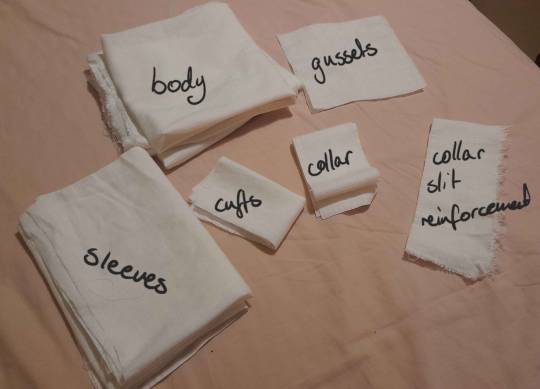
The collar slit reinforcement piece is just a scrap piece of fabric rn. Like I said idk what I'm doing for that yet.
Thats what I have for now! I'm lowkey planning on sewing most of this by hand, cause I'm that sort of person, so it might be a moment before I have a substantial update for if anyone is actually a fraction of the interested in this as I am sjfjskf.
#if anyone gets to the bottom of this post ilysm#nell jackson#costume recreation#renegade nell#sewing#cosplay
35 notes
·
View notes
Note
Hi! I'm on a regency binge at the moment and while Good Society is on my list, do you have any more regency games/systems to recommend?
THEME: Regency Games
Hello friend, I think I have a nice little selection for you to take a look at!
One thing to note is that some of these games are very gendered, providing roles such as “Matron”, “Nobleman” or “Countess” that is rather unavoidable. Sometimes this is simply part and parcel of playing in a specific era of history, and sometimes it is done purposefully, as games can often be commentary about certain issues that were prevalent at the time.
While I think you could likely make a non-binary character in these games if you really want to, I think that one of the appeals of playing in the Regency era is the strict social structures that created such rigid gender boundaries, and so I’m not surprised to see those boundaries enforced in these games.
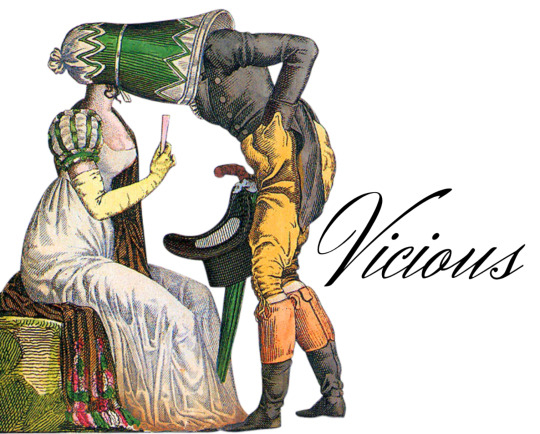




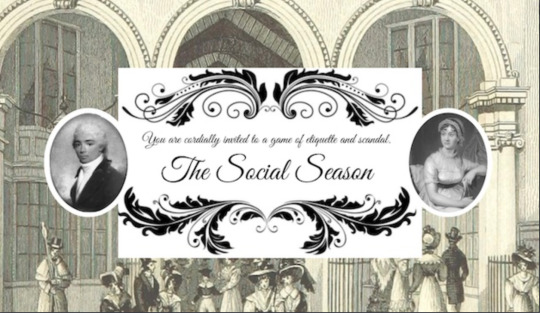

Vicious, by Budget Versailles.
Vicious is a game set during the Regency period about scandalous gossip told via letters between three or more players.
Players roll dice to generate scenarios and gossipy twists to pass on to the next player until everyone has been deceived with shocking slander and hearsay.
If you’re a fan of the epistolary phase of Good Society, Vicious is probably worth looking at. Watch a piece of news twist out of your control as your letters get flavoured with gossip. You can roll for inspiration for various scenarios, as well as for juicy gossip to make those scenarios even better - but the game ends with one player sends out an invitation to determine how many of the accusations that have been sent around are true.
I think Vicious is also an excellent add-on to pair with another game of your choice, especially since it could be played in between sessions, cooking up drama for the players to hash out in an in-person confrontation.
Hazelwood Abbey, by stevehatherly.
Downton Abbey meets Hillfolk. Players play an aristocratic family in a player-led dramatic game of emotional needs and wants for 4-5 players.
Hazelwood Abbey uses Pelgrane Press' DramaSystem rules engine to create a story of high-stakes interpersonal conflict. During the session, you will create family members with conflicting needs and goals. And then you will find out what happens.
To play this game you’ll need a good understanding of how the DramaSystem works. The author recommends referencing a copy of Hillfolk, although you can also check out the SRD for free to see how you feel about the system.
The DramaSystem is all about relationships, and give and take. Your characters all need something from each-other, something tied to an emotional reward. When interacting with each-other in a dramatic scene, tokens will be gained or spent by following prompts specific to your playbook. In Hazelwood Abbey, your characters are split between the upstairs and downstairs, just like in Downton Abbey. The upstairs playbooks will wrestle with ties to family, tradition, and duty, while the downstairs playbooks commonly struggle with ambition, social inequality, and precious secrets. If you deny another person what they seek, too many times, they may force an emotional concession from you by spending tokens.
I think this is a great example of dramatic tension, and while I suppose Hazelwood Abbey might be slightly later than regency era, it might give you some of what you’re looking for.
Sense and Sensibility, by Armanda.
YOU ARE A DEAD GUY’S SECOND FAMILY IN 18th CENTURY ENGLAND. Your mission is to get one of your sisters to marry well, since you’re all women and can’t live without the favor of a man. You have no rights other than the right to marry and be a mother. In this game, you’ll explore the terrible vicissitudes of British bucolic countryside life and deal with neighbours and city people coming to visit the various families in the area, where gossip and marriage (and love, in the best of cases) are the order of the day.
Since this game is built off of Lasers and Feelings, I’d expect it to also be fairly easy to pick up if you’re familiar with other works in the same system. You have two stats and a number somewhere between 2 to 5 that tells you how good you are at one of those things, and how bad you are at the other.
I think this game is more focused on family relationships than some of the other games on this list, because your entire family’s well-being depends on the success of finding a wealthy match. Battle gossip, defend your honour, and possibly even sabotage your rivals in an attempt to find some security for yourself and your loved ones.
The Season, by Rue.
It's London season and you're in for a ball!
The Season is a GM-less RPG about elevating your status and keeping up your reputation during the fabled Regency Era social season.
This is a competitive RPG that takes place over the course of 10 rounds. Each characters’ goal is the same: to end the game with the highest Reputation. To chip away at your rivals’ reputation, you’ll have to demonstrate your own social graces, spread rumours, or meet gossip with the perfect amount of composure. You just need 2d6 to play, although you’ll probably want a few roll-tables for inspiration if you don’t consider yourself that good at improv.
This is another game that might benefit from being played alongside something bigger, or perhaps using some established lore from another setting.
Teacup Masquerade, by Sam Scribbler.
A one-page cozy social game about getting revenge on your enemies. Inspired by Regency-era romantic dramas such as Bridgerton with a vengeful twist. Create a character, discover your rival's secret, and become the darling of high society.
This is a simple game meant to fit on one page. You have three basic stats, and a gradient scale of success. You gain a random social advantage and a random personal shame, which you’ll want to try to hide as you go about discovering the secrets of your rivals.
There’s not a lot of guidance for this one, which is pretty common for one-page games. It might be a good fit if you have an idea of the kind of story you want to tell, or if you have your own set of home-brew rules that you want to add onto an existing premise.
The Social Season, by Scott Sexton.
In this single page role playing game inspired by the works of Jane Austen, you and your friends play as high society characters navigating the treacherous London social season.
To save your family from ruin, you must land an advantageous marriage proposal by the end of the season. Will you outwit scheming rivals and jealous suitors to make a fortuitous match, or will you become embroiled in scandal and depart London in disgrace?
This is a Honey Heist hack, pulling you between the two extremes of Composure and Scandal. Since it’s built off of a familiar system (to me), I can expect this game to be rather light-hearted, pushing your characters to vacillate between following social graces or deliberately doing something considered… untoward. This is certainly a chance to put on your stuffiest airs, flutter your fans dramatically, and describe your attempt to kiss your beau on the back of their hand.
The London Season, by Stéphanie Dusablon.
The London season of 1874, a perfect time for the aristocracy to advance the marriage prospects of their offsprings, entertain themselves through various social engagements and, naturally, gossip to their heart's content.
We were also taught that once we attained marital bliss, our husband would take ownership of our wealth, property and body. They probably would have passed a law to ensure our mind became theirs as well, had it occured to them that we might actually have one.
Create your young lady, decide if you hope to secure or avoid an engagement this season and carefully navigate 8 fortnights of glamorous events, social engagements and secret messages.
As a solo roleplaying game, The London Season is an examination of the social inequities present in the Regency era, as well as a love letter for a time of secret messages and glamorous events. You’ll mostly be drawing cards to answer questions, receive secret messages, and navigate both welcome and unwelcome engagements, journaling each step of the way. At the end of eight fortnights, your young lady will have either achieved or lost her goal. Whether that goal is marriage or something else is up to you.
Games I’ve Recommended In The Past
Le Bon Ton, by RobotFrancis.
Pride and Extreme Prejudice, by Grant Howitt.
Eyes on the Prize, by ira prince.
56 notes
·
View notes
Note
I would use google Translate, but I prefer talking to a native speaker on this, I thought of giving the dragons family names and, for the royal families, their name being the name of their kingdom (but in different language so French for Skywings, Russian for Icewings, Arabic for Sandwings, Portuguese for Rainwings ect ect)
How would you translate Northfang ? I am not sure if Russian family names are litteral or not but since Wof Dragons are named with nature things it doesn't matter as much ^^
(Btw if you need help with french stuff I'm here)
Oh yeah, I also associate skywings with French culture (specifically medieval), and sandwings with Arabic culture. And it also seems to me that the royal seawings resemble the French nobility of the 18th-19th centuries. Perhaps this is due to the French rococo style, which is associated with the marine theme. Perhaps the royal seawings admired skywings at one time or something like that.
About the surname. Russian surnames really often denote some kind of activity or some phenomenon, action, thing, animal and many other things, and this is visible. I think that Northfang sounded in Russian as Severoklikov (the "i" after the l should actually be the "ы" sound, but it is not exist in English or French) or Severozubov (there is more of a tooth than a fang). Depending on the gender, the sound of the surname changes. Masculine: Severoklikov. Feminine: Severoklikova. If the character is non-binary, then to the pronouns "they/them", it would sound like "Severoklikovi" (well, the plural gender sounds the same). The neuter gender for "it/its" sounds like: "Severoklikovo". But both of these options actually sound very strange in Russian, haha.
In Russian, there are surnames that do not change depending on gender, but they are usually of foreign origin.
Anyway, I was happy to help! And about French... I'll take note ^^
25 notes
·
View notes
Note
Hey, so recently I saw a post about the misogyny of hamilton, so I wanted to ask you if it was true. Not the part of misogyny (because in that time it was normal, I guess), but rather how much was? (does make sense?), did it affect the relationship with eliza or with her daughters?
Thankyu!!! (Muak)
hm okay so im not completely sure what you mean but i am going to do my darndest
So, in the time period which Hamilton was alive, which is the latter half of the 18th century, there definitely was a profound attitude of misogyny, but it was very different from what we know today. Most of our idea of sexism comes from the religious revivals of the 20th century (and people who know me know how i feel about the godforsaken 20th century when it comes to history). This is yk your typical idea of a housewife being at home, taking on the burdens of homemaking and child rearing and basically keeping everything together at home while the husband worked a stressful 9 to 5 and didn't do shit at home and weaponized incompetence and implicit biases and yadayada
This was not the case in the 18th century! 18th century gender roles are very different from what we're used to, and even more different than what the Victorians and Edwardians considered the norm. This is especially visible in Hamilton's relationship with women, so I'm quite excited to talk about this.
Firstly, I want to talk about the joker to my batman: Ron Chernow. A major theory he supports in his biography of Hamilton is the two sided nature of Hamilton's perception of women. He says that there is a clear distinction between two "types" of women in Hamilton's wife-- the good, Christian mistress of the house and the stupid, mentally unstable skank. These are his terms. I want to hit him in the head with a brick.
"Together, the two eldest [Schuyler] sisters formed a composite portrait of Hamilton's ideal woman, each appealing to a different facet of his personality. Eliza reflected Hamilton's earnest sense of purpose, determination, and moral rectitude, while Angelica exhibited his worldly side- the wit, charm, and vivacity that so delighted people in social intercourse." -Ron Chernow, Alexander Hamilton, page 133
Yeah, this is horseshit. It gets worse when he compares Elizabeth Hamilton and Maria Reynolds on page 367, but I'm not going to get started because I won't stop. And this isn't about him anyway.
Instead, I want to talk about WHY this is horseshit. First of all, even Alexander "thinks with the wrong head" Hamilton didn't have this fucked up mindset, because it is heavily based in 20th century evangelicalism that didn't even exist in Hamilton's world.
Yes, obviously there was religious attitudes that condemned certain actions from women, but this was not as intense as in later periods. In the 18th century, an upperclass woman, such as Elizabeth Hamilton, would be responsible for maintaining the household, but this meant being in charge of the servants rather than doing the work herself. The work she did do would be maintaining the finances and the family's reputation.
Reputation was everything in the 18th century, and this especially applied to women. Not only did they have to maintain their own reputations, but they had to raise their children to have the skills necessary to do the same, and often had to fill in for their husbands in this department if they held public office. It's very difficult to maintain your reputation if you're beating people with walking sticks in the Continental Congress.
When it came to lower and middle class women, their jobs weren't different in that they carried an equally important role in the family. They would be doing household chores just as well as their husband, and these weren't easy chores that made women "feeble". They very often took a lot of physical strength and endurance, and it wasn't considered unladylike for women to do "men's" chores while their husbands were away. This isn't to say that women in later eras didn't do the same, but it wasn't as publicly frowned upon.
Hamilton had a very unique perspective as he was witness to both sides of this coin. His mother, a single, working class mother would be juggling both the man and woman's role. I think it was really this background that allowed him to have a much more informed perspective on womanhood. He was one of the few men in this period that I've seen write from the perspective of a woman, specifically a grieving mother.
"For the sweet babe, my doting heart Did all a mother's fondness feel; Careful to act each tender part And guard from every threatening evil. But what alas! availed my care? The unrelenting hand of death, Regardless of a parent's prayer Has stopped my lovely infant's breath-" -Papers of Alexander Hamilton, volume 1, page 43.
Chernow attributes this to Hamilton's deeply empathetic nature, which is fair, however I think it also shows that he was able to understand a woman's experience specifically.
I say this because Hamilton does tell us a little bit about exactly what was expected of women in the time during Elizabeth's first pregnancy in a letter that is usually used to call him a sexist, but I think it's a little more complex than that. Here's the excerpt:
"You shall engage shortly to present me with a boy. You will ask me if a girl will not answer the purpose. By no means. I fear, with all the mothers charms, she may inherit the caprices of her father and then she will enslave, tantalize and plague one half [the] sex, out of pure regard to which I protest against a daughter. So far from extenuating your offence this would be an aggravation of it." -Alexander Hamilton to Elizabeth Hamilton, October 12, 1781
In this letter, Hamilton isn't telling Elizabeth that he wants a boy to inherit his fortune, to carry on his name, or the other reasons that were given by his contemporaries for preferring sons over daughters. He specifically states that his reasons are his fear that his traits will be passed onto his children, and that if its a daughter, she will be more discriminated against than his son because of her sex. Essentially, it was easier to be a gay son in the 18th century than a thot daughter. In that question, Hamilton would choose gay son because he knew that men were generally less criticized than women.
So, I'm not saying Hamilton wasn't sexist, because, by definition, he was. He was taught that women were fundamentally different than men, but he didn't look down on women for that, because that simply wasn't normal. You wouldn't be a gentleman if you looked down on a woman for being physically and psychologically different from a man, you'd be an asshole. While their interpretations of these differences don't align with what modern medicine has determined, they weren't the same as in the later eras in American history. Women were, most certainly, oppressed because of these perceived differences, but it was a different system of oppression than what typically defines our idea of sexism.
It's hard to say if it affected Hamilton's relationship with his wife and daughters, as there isn't any real written proof, but I imagine Hamilton's attitude specifically towards women did make their relationship different than other fathers, daughters, husbands, and wives of the time. We do know that Hamilton was a very hands on father who dedicated a lot of time and care towards his children, and he did not treat his daughters any differently than his sons. He put the same amount of energy into their education, though they weren't educated in the same thing, and he seemed to be equally close with all his children.
Hamilton and women is a very interesting topic, and it gets more complicated when it comes to Rachel Faucette and Maria Reynolds and those parallels, but that is a topic for another time. Good thing its women's history month! Hope this helped :)
#alexander hamilton#history#amrev#american history#elizabeth hamilton#women's history#18th century#founding fathers#founding mothers#women's history month#asks#publius originals
59 notes
·
View notes
Note
If you were to rewrite Innocent or Innocent Rouge, what aspects would you change and why?
Good question! I'd rewrite some unrealistic events that happened in Innocent. Because— who, in 18th century France, would place a grumpy 11 year old girl as the Prévôté de L'hôte of Versailles? That wouldn't be likely at all especially when people during this time were heavily misogynistic. Maybe she'd claim the title realistically as a late adolescent, and was more wiser first.
The backstory of Zero. No way Marie Joseph gave birth to a baby all by herself during a fucking revolution. How the hell did they even survive that? Marie Joseph cut all her connections with her family and abandoned her occupation. Money wouldn't last her long in that kind of economy, and being a vagrant isn't exactly safe for her or her child. Especially since she's a first time mom with no experience with a baby. Like, there are things that even your research books can't answer, Marie.
How was Zero able to participate in society without a gender? Have proper education, and living? It's very modern thinking I admit, but bro how are you even living and breathing surrounded by a bunch of conservative folks? I would wanna shine a bit of light on Zero and Marie Joseph's growing lifestyle together.
Marie Joseph's character is fascinating. She's intelligent and ambitious and driven, but she's a bloody brute. Super fictional and too unreal. I'd rewrite her to be more human. The woman had experienced some trauma, but that was overlooked throughout the manga. Like I wish we have more background on that and how it affected her throughout her life. Strong feminist characters have vulnerable moments too and that's perfectly okay. But apparently not for Shinchi Sakomoto's characters. Just suffering because 'trauma builds character'.
Also, I won't hesitate to rewrite Marie Antoinette's entire character. I feel like Shinchi Sakomoto wrote her in the way Marie Antoinette was portrayed in media propaganda.
Her relationship with her bodyguard is very intriguing and I'm obsessed with it. But what are Marie Joseph's motives with starting an affair with the Dauphine in the first place? To piss off Du Barry for sleeping with her brother?? C'mon. And I'm pretty sure Antoinette would be initially self-conflicted with her romantic feelings for Marie Joseph. As she was a raised Catholic, taught to think "homo = no no". Someone like Antoinette, who's eager to please those around her and make a perfect impression... she'd hesitate before accepting Marie Joseph's hand. But then again, Antoinette thinks the more forbidden it was, the more exciting. I had hoped that Antoinette and Marie were set for on plot-road focused on complex infatuation and frustrating miscommunications. But no.
The ending of Innocent Rouge was also very rushed. Like whyyy?? Shinchi probably just wanted to get it done so he can focus on #DRLC.
#innocent rouge#innocent manga#marie joseph sanson#Zero Sanson#Marie Antoinette#marie antoinette innocent
20 notes
·
View notes
Note
Hi!
I was just cleared by my professor to write a 35 page paper concerning the relationship between Hamilton and Laurens.
I've been following your blog for a while now and truly appreciate the nuance you approach 18th century relationships with homoerotic subtext. I was wondering if there are any sources or articles that you could think of that could possibly help? I'm trying to be as thorough as possible with this project and figured that the good people of tumblr would be a great place to start!
That's so exciting!
I've already shared a bunch of general/context-setting works here, some of which include mentions of the Laurens-Hamilton relationship. You especially want the Godbeer text.
Here are a few other articles that might be worth looking at:
Weir, R. M. (1976). Portrait Of A Hero. American Heritage, 27(3).
Lyons, C. A. (2003). Mapping an Atlantic Sexual Culture: Homoeroticism in Eighteenth-Century Philadelphia. William and Mary Quarterly, 60(1), 119.
Haggerty, G. E. (2012). Gray Agonistes: Thomas Gray and Masculine Friendship. The Age of Johnson, 22, 331–XIII.
Richter, S. (1996). The Ins and Outs of Intimacy: Gender, Epistolary Culture, and the Public Sphere. The German Quarterly, 69(2), 111–124.
And then a few considerations from me (because I've never seen a soapbox I didn't want to climb on):
Context is everything. If you're looking to evaluate the relationship effectively, make sure you are consulting sources that cover the right social, cultural and temporal contexts (in this case, Anglo-American late 18th century). Male-male relationships underwent a lot of change during the 18th century, as did the socially-acceptable (or not) codes and expressions. They also varied a lot by culture, so a source about men in France in the 1720s is only going to be tangentially relevant here.
Be sure to consider adjacent topics like masculinity, virtue, family life, and the influence of antiquity. All of these helped to model what a man should aspire to be, and how he should engage with the other people in his life (and thereby, what would count as transgession).
Don't forget friendship! Whatever else Laurens and Hamilton were, or however else we want to label it, they were also close friends. This sometimes gets erased or overlooked and it's very frustrating. Friendships were the cornerstone relationships of young men's lives at the time - sites of companionship, values-building, intellectual stimulation and social support.
Good luck with your paper!
18 notes
·
View notes
Text
Geneviève d’Eon & Marie-Jeanne Bertin: Clothing and Gender in 18th Century France
"After being fully dressed by famous designer Rose Bertin for the first time, they ran to their room and cried for hours." ~ Kaz Rowe, The Chevalier d'Eon: the Trans 18th Century Spy
Kaz Rowe throws this story out there in their video on d'Eon as a part of their justification in using they/them pronouns for d'Eon who used she/her pronouns. Rowe never really explains the context for this story. It sounds dramatic on the surface, d'Eon spent hours crying over being forced into women's clothes. But did this really happen?
This story comes from d'Eon's own autobiographical writings that she never finished. Segments of her drafts were translated and published by Roland A. Champagne, Nina Ekstein, and Gary Kates in The Maiden of Tonnerre. The title comes from d'Eon who styled herself la pucelle de Tonnerre after Joan of Arc who was known as la pucelle d'Orléans.
Some things to consider before we start:
D'Eon's autobiographical writings operate under the pretence that she was afab and raised as a boy for inherence reasons. We have to remember that these writings are heavily fictionalised, a necessity in upholding the lie that allowed d'Eon to live as a woman. However that doesn't mean that there is no historical value in these writings. Instead of simply taking these stories as fact we must consider: Why is d'Eon presenting this story in this way? How does this story serve the narrative d'Eon is constructing for herself?
D'Eon in this story claims she had never worn women's clothing before. This is contradicted by d'Eon's own claim of infiltrating the court of Empress Elizabeth of Russia as a woman. While its hard to pinpoint the exact moment d'Eon first wore women's clothes I personally suspect it was much earlier than this.
D'Eon also includes a scene where she is bathed by Bertin's assistants. This scene is almost certainly fictional as if it happened in reality this would reveal that d'Eon had a penis, a fact she wanted to keep secret. This scene is almost certainly included to add to the 'evidence' that d'Eon was afab.
Considering these points we must consider that this story did not take place literally as d'Eon depicts it. Instead of taking this story as an accurate recollection of events I consider it a fictionalised story (based on true events). The goal in my analysis is to ask what is d'Eon trying to communicate though this story.
Some background information to add context:
D'Eon had prior to this incident signed a transaction with Louis XVI in which she was legally acknowledged as a woman and ordered by Louis XVI to wear woman's clothes. D'Eon agreed to "declaring publicly my sex, to my condition being established beyond a doubt, to resume and wear female attire until death," but then adds "unless, taking into consideration my being so long accustomed to appear in uniform, his Majesty will consent, on sufferance only, to my resuming male attire should it become impossible for me to endure the embarrassment of adopting the other". (see D'Eon de Beaumont, his life and times by Alfred Rieu, p174-182 for an English translation of the transaction)
We also must consider that d'Eon did not dispute the fact that she was a woman when signing the transaction, nor does she dispute this in her autobiographical writings. D'Eon was very much arguing that she, as a woman, should be allowed to continue to wear men's clothing (specifically her dragoon uniform) as that is what she was used to wearing and comfortable wearing.
Also mentioned in the following excerpt is the English trial over d'Eon's sex in which it was found that d'Eon was a woman. I'm not going to get too into the topic here as it's a whole other can of worms. However I think it's important to understand that while d'Eon had issues with aspects of the trial she would use the ruling to support her claim that she was afab.
The Maiden of Tonnerre: Chapter VII
Selections from the great interview between Mademoiselle Bertin and Mademoiselle d'Eon in Paris on October 21, 1777 Mademoiselle Bertin. I have come vary early in the morning to spare you trouble and embarrassment. But what else can I do? You must either go through this or through the gates of a convent. Mademoiselle d'Eon. It is easy to do otherwise. Just leave me as I am. I have lived for forty-eight years this way. I cannot live all that much longer. I am impatiently awaiting the great change that will transform us all making all of us eternally equal. Mademoiselle Bertin. The Court in its patience will never have the endurance to wait that long. Remember that it was a deliberate error on the part of your father, your mother, and yourself that resulted in Mademoiselle d'Eon's wearing men's clothing and a military uniform. But since that time things have changed considerably, and today by order of King and the law, the bad boy must become a good girl.
It's interesting that here d'Eon has Bertin distinguish between "men's clothing" and "military uniform". As women were not allowed in the French military at this time all French military uniforms were as such men's clothing. But d'Eon did not simply want to wear men's clothing she wanted to wear her military uniform.
Mademoiselle d'Eon. If I was a boy by mistake, one could inadvertently allow me to continue to be one. While you are correct about the substance of the matter, I am not wrong about the form. Mademoiselle Bertin. That is not possible now. Your trial created too much of a stir. Mademoiselle d'Eon. I am a reliable bugler in my squadron. I am not frightened by noise. The Court's behaviour, by its very decency, has wound up being indecent. I would have thought that the King would have been willing to allow me to wear the uniform of a former dragoon captain, Knight of Saint Louis, and plenipotentiary minister, since he was kind enough to allow me to wear the cross of the royal and military order of Saint Louis on my dress. Do you see how everything at court is so arbitrary? There one could say every day: Contraria contrariis opponuntur [A contrary opposes other contraries].
Again we see the focus is that d'Eon wanted to wear her dragoon uniform. She likens this directly to her cross of Saint Louis which Louis XVI did permit her to wear on her women's clothes. As the cross of Saint Louis was only awarded to men it is arguably also menswear. D'Eon is pointing out the arbitrary nature of this distinction. Why is she permitted to wear an idem of menswear, the cross of Saint Louis, but not another, her dragoon uniform. To d'Eon these both represent her achievements rather than manhood, she is arguing that she, a woman, should be allowed to wear them.
Mademoiselle Bertin. I concede that every day we see in the streets of Paris a tall young woman in the uniform of a dragoon publicly giving lessons on the use if arms. But remember that this girl was a mere dragoon and that she had no other way to earn a living. To do so, she had written permission to dress as a dragoon form the lieutenant general of the Paris police. But the Court would never grant such permission for a young woman from a good family who had been in France and in foreign courts as Mademoiselle d'Eon has been. Mademoiselle d'Eon. In a well-regulated country, the law must not allow preferential treatment to anyone. Mademoiselle Bertin. You can go to Versailles to argue with the Chancellor of France, your former schoolmate. But with Mademoiselle Bertin, it can serve no purpose to argue. Do not take this matter so far as to have a falling out with the King's ministers or the royal Treasury. Remember, Mademoiselle, that in France a maiden who obeys the law and the King must wear her dress and petticoat, whether to remain in this world or to spend her time in the convent. Mademoiselle d'Eon. Your advice is wise and prudent. I would rather follow you into the royal Treasury than into a convent. Mademoiselle Bertin. My honorable captain, don't think that you are dishonored by having been found to be a woman. The discomfiture is temporary, and the glory will be with you forever. But let us not wast uselessly the precious time needed to begin and end your outfitting before the return of Major Varville. Mademoiselle d'Eon. I see that Mademoiselle Bertin is correct about all that she says and does and that a lady-in-waiting to the Queen is thus wiser in her comportment and in her begetting than all the children of the Enlightenment and all the captains of the army. Without delaying further and having followed the instructions of Mademoiselle Bertin, the Dragoon was, in a short period of time, divested of his serpent's skin and transformed into an angel of light. Her head became as lustrous as the sun. Her whole outlook on things changed as much as did her face. No trace of the dragoon remained in her. Mademoiselle Bertin thought she was consoling me by saying: "The Queen doesn't despise bravery in a well-born maiden. But out of duty she prefers to find in her decency, honor, and virtue. If Louis XV armed you as a Knight of French soldiers, Louis XVI arms you as a chevalière of French women. And the Queen crowns your wisdom by commanding me to bring to you this new armor, which must accompany your coiffure and your demeanor so that you may become the leading general of all the honorable women of France. The time has come for us to be edified and not scandalized by Mademoiselle d'Eon's conduct. Why don't you offer up your uniform as a sacrifice at Notre Dame de Paris or in your holy anger throw it out the window in order to stand witness before the people of Israel, the Parisians, the Scribes, and the Pharisees that you are now following the letter of the law that Moses gave us in his commandments." While Mademoiselle Bertin had me get into the bath to be washed, soaped and scrubbed down by her companions, I told her: "Proceed as quickly as possible; do not waste time with the preparations so that I too may keep part of my own dignity as it is joined with yours and that of your seamstresses. Virtuous Bertin, honest messenger form the chamber of the Queen, I fully realize that the hour is at hand for me to follow the directive of the law and the King. As a victim, I am offered up in sacrifice since you do me harm in order to do me good. All women are going to point at me, and all the maidens are going to thumb their noses at me when they see me dressed in style and done up like a doll or at the very least like a Vestal Virgin who is led to the marriage altar."
We see in this excerpt Bertin acts as an authority ushering d'Eon into womanhood, the transformation is painful but ultimately positive for d'Eon; "you do me harm in order to do me good". But there is this real fear of being mocked by other women. At least part of d'Eon's trepidation to don women's clothes comes form the fear of humiliation. We see this fear also reflected in the transaction when she begs King Louis to "consent, on sufferance only, to my resuming male attire should it become impossible for me to endure the embarrassment of adopting the other".
Mademoiselle Bertin. Put aside your concerns about what other will say. Must what the mad say prevent us from being wise? Mademoiselle d'Eon. Alas, at court everything is beautiful. To please the court, does a former captain have to become a pretty boy [demoiseau]? Mademoiselle Bertin. Yes, absolutely, when the so-called "boy" is discovered to be in fact a girl by the systems of justice both in England and in France. Mademoiselle d'Eon. Speaking of justice, is Mademoiselle Bertin, the Queen's servant, also the enforcer of justice? Mademoiselle Bertin was stung. "Don't be angry," I told her, "I simply wanted you to acknowledge, for you are just in all matters, that I cannot fit into the dress you brought me." Mademoiselle Bertin remained disconcerted for a moment. But she soon regained her composure and said to me: "If you are a patient girl, the dress that I made for you in the name of Justice will soon be taken out to fit you. And I predict for you that the certainty of happiness will come form the alleged abyss of your unhappiness." Then, looking pleased with herself, she said to me: "I am glad about having stripped you of your armor and your dragoon skin in order to arm you from head to toe with your dress and finery. In you I have found the power to possess the benefit of simple tonsure without a papal dispensation. Give thanks to God. You can assuredly double your chances of attaining eternal life, for which all of us search amidst this life's sorrows, troubles and suffering. Tomorrow you will suffer less, and the following day you will not suffer at all. In a little while, you will enjoy the relaxation and the joy that are the natural prerogatives of a Catholic girl who loyally follows the breviary of Rome and Paris, which was annotated, revised, and made available to the Daughters of Holy Mary and the Queen's women. You are not yet canonized, but soon you will be beatified when your upcoming marriage is canonically approved. Better this for you than a cannon shot."
D'Eon at this time was considering joining a convent. Bertin is referring to d'Eon's marriage to Christ.
Mademoiselle d'Eon. You can even say that regarding a hail of cannon shots. ... But when I reflect on my past and present states, I will never have the courage to go out in public dressed as you have me. You have illuminated and brightened me up so much that I dare not look at myself in the mirror that you brought me. Mademoiselle Bertin. A room is not lit up in order to hide it or to keep it in the dark, but rather it is placed beneath a chandelier so that those who enter can see the light and be edified by your conversion. Mademoiselle d'Eon. I know that there is nothing hidden that should not be revealed or anything secret that cannot be known. Therefore, I will not seek my own willpower but that of the King who sent you here to Mademoiselle d'Eon to change what is bad into something good. Since he obliges me to choose the best way, it will not be taken away from me. What is worth choosing is worth maintaining. When you came to me, I thought you were bringing me death. Now I go to you in order to be alive, because I am no longer chasing after the false vainglory of the dragoons, but after the solid glory of maidens of pease. I am no longer looking for my own glory. There is another who is seeking it for me and is judging it. This order is the most Christian King following the opinion of his Council and his apostolic Sanhedrin, who grants me glory so that I myself might experience that God's will is perfect, that will of the law is just, the King's will is good, and that of the Queen pleasant, decent, and proper, because the Son of Man came to save what was lost. After this conversation, I quickly left the room and hurried to my bedroom, where I wept bitterly. Mademoiselle Bertin closely followed me and uselessly proposed both a drink and smelling salts in order to console me. I stopped crying only when my tears naturally dried up. Mademoiselle Bertin, as a crafty member of the Court, took advantage of my weekness by saying: "You are certainly not unaware of the joy experienced by the public in Paris when they heard sung the verses about the Heroine from Tonnerre, which were recently printed and are being sung throughout France." That was the only thing that calmed me in my distress, for when a heart is not entirely dedicated to God it is partly attached to this world. Only vanity can console such an individual because this world prefers human glory to the divine.
And so that it. Thats the moment that d'Eon "cried for hours" after being dressed by Mademoiselle Bertin. So what is d'Eon trying to communicate to the reader in this excerpt?
"When you came to me, I thought you were bringing me death. Now I go to you in order to be alive" is a key part of d'Eon's speech to Bertin, it mirrors an earlier moment in chapter VI where d'Eon says to Bertin "You have killed my brother the dragoon. That leaves me with a heavy heart." In order for d'Eon to become a woman the man or more precisely the dragoon must be killed. D'Eon tries to hang onto both womanhood and her identity as a dragoon but she isn't allowed to.
She cries in morning for the loss of the dragoon she once was and is only cheered by Bertin reminding her that she is now a Heroine. However the d'Eon who is narrating this story criticises her past self for vanity. We see this thought continued in the next chapter:
There is no doubt that it would have been preferable, for my happiness in this world and my salvation in the one to come, had my investiture taken place forty years earlier, because the dragoon disease is so deeply rooted in me that I greatly fear that our saintly Madame Louise will unite with our holy Archbishop, the good Marquis de l'Hôpital, and his pious spouse to have me put away in a hospital for the incurable.
D'Eon presents her transformation into womanhood at the hands of Mademoiselle Bertin as a painful experience but ultimately a necessary and good one that brought her happiness in the long term. I'll leave off with d'Eon's words:
That was all I could respond to Mademoiselle Bertin's questions, whether they were hers alone or form on high. I answered them in a satisfactory manner according to my system of moderation, so appropriate to my position and to the disposition that heaven has inspired in me, and not that of the dragoon, which I drove out of my clothes and away from the wardrobe that the honorable messenger of the Queen had brought me. Thus I can say without flattery that Mademoiselle Bertin is the best of the women who can be found at the Court, in the city, in Picardy, in France, and in the world. My dear Mademoiselle Bertin, it will soon be midnight return to rejoin your forty Virtues as if it were midday.
85 notes
·
View notes
Text
re: elf servants
I think generally there are servants in royal/noble households simply for practical reasons and they generally fall into 2 categories: specialised servants (think, stewards and messengers and scribes, masters of horses or kennels, that kind of thing) and servants who help with the upkeep of the household (cleaning, repairs, cooking and also the apprentices and assistants of specialised servants)
specialised servants are probably quite prestigious roles and fields of industry in their own right, and they are considered full members of a household, and probably are closely linked to the person they serve - it's as much a political and social statement to be Finwe's chief scribe as it is an economic one
but the second category are more associated with the house than the family living in it - for example, Finwe's palace in Tirion would function both as a home and a diplomatic and administrative centre, it would be impossible for him to rule and keep up with chores himself. But Fingolfin's personal home would probably not have any full-time servants - when there more people than usual to feed or house then professionals might be hired, but for the most part I imagine the day to day is done by the family (made possible by the fact elves sleep and eat less than humans)
IRL domestic service (at least in the 18th century) often functioned as a kind of prep stage for adult life (for women in particular, but gender is probably not as big a factor for elves) and I could definitely see this in Valinor - domestic servants being 80% elves between 50-100 who haven't chosen an apprenticeship or similar in another field who are earning extra money to set up their own households, getting experience outside of the family, meeting others in their own ae cohort, learning independence etc. It's a job that comes with the offer of room and board + the wages a king/prince/lord can provide. Not glamorous, but not terrible.
The other 20% is made up of professional servants - experienced elves who are genuinely like the work and are contracted workers as much as a builder or gardener might be. Some of them might be independent and others part of businesses set up by other elves who are really into cooking/cleaning etc.
In Beleriand the situation (for the exiles at least) is probably very different, though I think there would be attempts to adapt the system - but there aren't as many households that need servants and there aren't as many young elves.
#i confess i very much enjoy making ocs who are bg characters and servants are perfect for this#made my own post because i could not fit this in the tags LMAO#also the amount of labour needed to run a pre industrial household is HUGE#but elves generally get around this by having a population that is 90% adult and having magic#and having the time for anyone to become vastly skilled in their field in a lifetime#so things like food and clothing production is almost always communal and in the hands of elves who are REALLY into that specific area#the magic being relevant here because elf magic preserves - elven clothes won't wear out elf food doesn't go off etc#(or at least not as easily as human food/clothes)#i prefer to write elf societies that only visually mirror human ones - to an outsider it looks like a hierarchy of lord and servants#but the dynamic is very different#but that is just my preference#silm meta#not really a meta i just need to be able to find this post on my blog lol#long post#this is one of my fave topics hence the rambling
126 notes
·
View notes
Text
Having played parts from Prospero to Stalin, Hamlet and now the poet AE Housman, Simon Russell Beale is convinced he has one of the best jobs in the world. Why? Every new role offers a new area for intellectual investigation, not least when he gets to take on the logical arguments and ‘linguistic fireworks’ of one of his friend Tom Stoppard’s plays, he tells Fergus Morgan
You cannot complete acting – but if you could, Simon Russell Beale would be coming close. Over a three-decade career, he has taken on dozens of classic roles in canonical plays: Konstantin in The Seagull, Ferdinand in The Duchess of Malfi, Oswald in Ghosts, Lopakhin in The Cherry Orchard, Scrooge in A Christmas Carol, the title characters of Edward II, John Gabriel Borkman and Uncle Vanya, and loads more.
And, when it comes to Shakespeare, there are few parts the 63-year-old has not played. Hamlet? Tick. King Lear? Tick. Macbeth? Tick. Richard II and Richard III? Tick, tick. Benedick, Iago, Malvolio, Leontes? Tick, tick, tick, tick. Falstaff and Prospero? Tick, tick.
With a theatrical résumé as comprehensive as that, where does Russell Beale go next? In a recent interview with the Telegraph to mark the release of A Piece of Work, the memoir he “slightly sheepishly” wrote, the actor said he would be keen on playing Cleopatra. Why not? It would not be his first foray into gender-swapped Shakespeare: he played both Hippolyta in A Midsummer Night’s Dream and Desdemona in Othello as a schoolboy.
“Unfortunately, I wasn’t being serious,” Russell Beale says. “I was being facetious, although I did see Mark Rylance do it 20 years ago and it was sensational. It is one of the great parts, but I don’t think that would work. It would probably be too scary for the audience.
“I would love to do Falstaff on stage as I’ve only done that on film,” he continues. “I would like to do another King Lear. I wasn’t particularly happy with my Macbeth, so I’d quite like to do that again one day. I’m getting a bit old now, though, so it has become slightly difficult. Perhaps one day I should try my hand at directing. I don’t know, really.”
Before he has a go at directing, or revisits Lear, or has a stab at Cleopatra, Russell Beale will be playing poet AE Housman in Blanche McIntyre’s revival of Tom Stoppard’s The Invention of Love at Hampstead Theatre in north London. Our interview is taking place via Zoom, with Russell Beale – black jumper, big beard – sat in an office somewhere inside the Swiss Cottage venue.
“There’s a very good novel here about Booth, the man who assassinated Lincoln,” Russell Beale remarks, browsing the bookshelves in front of him. “Anyway, nice to meet you.”
Russell Beale’s pre-interview bookshelf inspection confirms what he subsequently says about his character, about his approach to playing parts and about his professional motivations. He is, first and foremost, driven by an insatiable intellectual curiosity. He once described acting as “three-dimensional literary criticism”.
“I have one of the best jobs in the world, really,” he says. “Every single project potentially offers a new area of study. I know that sounds sort of dry, but if someone says: ‘I’d like you to do a play about a poet in the late 19th century who also happened to be the greatest classical scholar of his time,’ I think: ‘Wow.’ And, for a very short period of time, I get to become a bit of an expert on AE Housman.
“Or take Samuel Foote,” he continues, referencing the 18th-century actor and title character of Ian Kelly’s play Mr Foote’s Other Leg, which he played at Hampstead in 2015. “Doctor Johnson called Foote the most famous man in England, but I’d never heard of him. Now I could tell you all about him – where he lived, how he was arrested for sodomy and the legal case that followed. That sort of intellectual buzz is, I think, the most interesting thing of all about acting.”
Different jobs have different intellectual appeals, says Russell Beale. Some plays are stimulating for their historical subject matter. Shakespearean work is all about “digging around in this incredibly complicated, malleable script to find the emotional life of a character”. Other projects are attractive on a conceptual level, he says, like Joe Hill-Gibbins’ drastically cut, fast-forwarded staging of Richard II at London’s Almeida Theatre in 2018.
“I was far too old to play Richard II,” Russell Beale says. “I’d sort of assumed that was one part I would never do. Then along came this director who wanted to do it in a completely different way. It was incredibly cut down. It was staged straight-through with all the other characters milling around on stage. That was the challenge there.”
From screen to Stoppard
Where, then, does Russell Beale’s work in film and television fit in, beyond boosting his bank balance? His screen CV is not as formidable as his theatrical résumé, but it still encompasses Armando Iannucci’s comedy The Death of Stalin, the latest series of HBO’s blockbuster House of the Dragon, and the forthcoming Downton Abbey film.
“I suppose I just do that for fun, although I do have an interest in how those projects work,” Russell Beale says. “Take House of the Dragon. I remember wondering how they physically achieve a show like that. That was intriguing to me. I thought: ‘How the hell do you do a great big castle in a thunderstorm?’ It was this huge set with water literally cascading down the walls. The sheer skill was extraordinary. That was fascinating.”
If any writer could satisfy Russell Beale’s voracious intellectual appetite, it is Stoppard, whose plays frequently dazzle with their virtuosic use of history and intertextuality. Think of Rosencrantz and Guildenstern Are Dead, his existential 1966 riff on Hamlet that echoes Samuel Beckett’s Waiting for Godot. Or 1972’s metaphysical murder-mystery Jumpers, perhaps the most philosophically and athletically gymnastic play ever written.
Those Stoppard plays are the only two that Russell Beale has performed in until now. He played Guildenstern at the National Theatre in 1995, having previously performed in the play as a teenager, then took on the lead role in Jumpers – the philosopher George Moore – at the same venue in 2003. That production transferred to New York, and provided Russell Beale’s Broadway debut. The New York Times critic Ben Brantley hailed a “dazzling” performance of “sharp inventiveness and peerless emotional depth”.
“I’ve only done two Stoppard plays, but I’ve always been quite fierce in defending him against accusations of being over-intellectualised,” Russell Beale says. “Stoppard is intellectual, of course. He plays intellectual games. But what Stoppard always comes down to is people feeling passionate about something, usually another person. That, I think, is fundamentally the most important thing about his writing.
“Rosencrantz and Guildenstern is about two men who are lost in a world they don’t understand,” he continues. “Jumpers is about trying to cling on to a broken marriage. I saw The Real Thing recently at the Old Vic, which I saw with the great Stephen Dillane a couple of decades ago. That play is more directly about love than anything else.”
Playing with words
The Invention of Love, which premiered at the National in 1997, begins in the afterlife. Housman, dead at 77 in 1936, stands on the bank of the mythical river Styx, preparing to board a ferry. The play then unfolds through Housman’s memories of his time studying classics at the University of Oxford, with the older Housman – played by Russell Beale – interacting with his younger self, played by Matthew Tennyson. At the heart of its fizzing academic ideas is Housman’s unrequited love for fellow scholar Moses Jackson.
“The play is very complicated,” says Russell Beale. “This morning, we were rehearsing this very elaborate scene with all these 19th-century academics playing croquet. Stoppard ties in so many references to Victorian cultural icons like Jerome K Jerome and Henry Liddell and Lewis Carroll, too. Everyone has these great arias about philosophy and art.
“Underneath that, though, it is about an old man remembering his love for another man,” Russell Beale continues. “It is about a particular event in their lives, a rowing trip on the river when they were both at Oxford. It is about memory. It is about what you do with a love like that. It is about what a love like that means at the end of your life.”
The “incredible enjoyable” challenge of performing the play, says Russell Beale, is really getting to grips with its intellectual complexities and “linguistic fireworks” – as is the case with most Stoppard plays. If you can master the tongue-twisting dialogue and head-scratching arguments, he says, then the profoundly emotional core of the drama will come.
“Years ago, I remember the actor John Wood, who was one of the great language magicians, talking about Bernard Shaw,” Russell Beale says. “Now, I don’t particularly like Bernard Shaw, but Wood said that if you observe all the punctuations that Bernard Shaw set down as indications of when to breathe and so on, he does the work for you. “It is sort of like that with Stoppard,” Russell Beale continues.
“It is like a technical exercise. You have to end the sentence when it ends and make sure you give yourself gaps to breathe. And then it is about the clarity of the argument. The play does explore emotion. The word ‘love’ is in the title, after all. But performing it is not an emotional thing. It is more about a series of arguments. If you can get the grammatical, syntactical construction of the sentences, and then the actual logic of the argument, then you are on your way.”
It helps, says Russell Beale, that director McIntyre read classics at Oxford herself.
“My God, she does know what she is talking about,” he says. “I have no idea what I’m talking about when it comes to Latin or Greek, but she does have that string to her bow.”
The admiration is mutual. Via email, McIntyre says that she finds Russell Beale “extraordinary”.
“I think he is our greatest living Stoppardian actor,” she writes. “The wit and depth of feeling he brings to the character are breathtaking. It’s a privilege to watch him work.”
It helps, too, that Russell Beale is friends with Stoppard, who turned 87 this year. In fact, he adds, he received a first-hand insight into the playwright’s process of putting The Invention of Love together nearly 30 years ago when performing at the National. “I met Tom, I think, when we did Rosencrantz and Guildenstern,” Russell Beale says. “My memory is that he was writing, or thinking about writing, The Invention of Love at the time, because I remember he gave me a lift home once because he was driving in the same direction, and he started talking about Oscar Wilde and Housman on the way.
“I’ve known Tom for years now,” Russell Beale adds. “He was in last week, actually. He was on great form. He likes revisiting his plays, I think. He reads the script very intently, as if he is rediscovering it. It is rather lovely to see him do that. It’s quite moving, actually.”
Russell Beale was born in Penang in what was then Malaya – now Malaysia – in January 1961, one of six children of military physician Peter Beale, who would later become the British Army’s surgeon general, and his wife Julia, who was also a doctor. He was sent to boarding school, first at St Paul’s Cathedral School, where he was a chorister, then at Bristol’s Clifton College.
It was there that Russell Beale first discovered his love for performance, both theatrical and musical – he is an accomplished pianist, oboist and singer, and frequently presents radio and television shows about classical music. He has often credited a stern English teacher called Brian Worthington with instilling in him that respect for intellectual rigour and academic curiosity.
He went on to study English at the University of Cambridge, where he threw himself into student drama and made friends with Tilda Swinton, then trained at Guildhall, initially as a singer before switching to acting, graduating in 1983.
He started his professional career at Edinburgh’s Traverse Theatre, but his big break came two years later with a role in Women Beware Women at London’s Royal Court, alongside a young Gary Oldman. It was not until 1991, however, five years into his long relationship with the Royal Shakespeare Company, that Russell Beale felt like he could fully express himself on stage, when he was cast as Konstantin in a production of Chekhov’s The Seagull staged by the company’s director Terry Hands.
“Until then, I’d done a lot of comic parts,” Russell Beale says. “That was the first time somebody said: ‘No, you can do something serious. You can play someone with an emotional life that is serious.’ Terry did it deliberately, I think. He thought: ‘Here’s this guy who is being typecast and I’m going to cast him against type.’ And that changed my life. It led to people suggesting I do Hamlet and other stuff. I am enormously grateful to him.”
It was Hands, too, who forged one of the great collaborations of Russell Beale’s career, with director Sam Mendes. The pair first worked together at the RSC in the 1990s on productions of Troilus and Cressida, Richard III and The Tempest, then at the National Theatre on Othello in 1997 and, at the Donmar Warehouse, King Lear in 2014 and Twelfth Night in 2002, as well as on the globe-trotting production of The Lehman Trilogy in 2019.
“Sam and I have been doing stuff together for 30 years and it was Terry that put us together,” Russell Beale says. “Sam actually called me when Terry died in 2020. I was in the dressing room for The Lehman Trilogy in New York. He was very emotional. He told me Terry had died and that he was the one who had originally put us together. Terry was the one who said to Sam: ‘I think you’d like that actor over there.’”
There is an alternate reality in which Hands never cast Russell Beale as Konstantin in The Seagull and Russell Beale continued working as a comic actor. He would no doubt have been successful – witness his hilarious turn as spymaster Lavrenti Beria in The Death of Stalin – but he would not have plumbed the remarkable depths he has in this world.
What makes him stand out as an actor – and what has earned him countless accolades, including three Olivier awards, two BAFTAs, a Tony and a knighthood – is his ability to incarnate familiar characters in unexpected ways. He has played the majority of the most famous roles in the classical canon, but his interpretations are always invested with a distinct air of isolation or awkwardness. Perhaps it has something to do with the fact that he has frequently approached those roles at an unconventional age.
“In retrospect, my career sort of looks like this marvellous plan, but it wasn’t,” he says. “It was all an accident. I’ve done all the parts at the wrong age. I was a very old Hamlet and a very old Benedick, and a very young Richard III and a very old Richard III.”
Empathy with outsiders
Nicholas Hytner, another director with whom Russell Beale has a long relationship, having starred in his stagings of The Alchemist, Much Ado About Nothing and Collaborators at the National Theatre in 2006, 2007 and 2011 respectively, and, more recently his versions of A Christmas Carol and John Gabriel Borkman at the Bridge Theatre in 2020 and 2022, has said of Russell Beale: “He has extraordinary empathy with outsiders, the wounded, the foolish, the warped and the lonely. He hears their music and can sing it.”
“What did he say?” asks Russell Beale. “I’ve not heard that before. That is the most beautiful, lovely thing to say. And yes, I’m always excited by those characters. The most interesting parts are those that are looking in from the outside or confused about their position. I don’t know what that says about me. I’ve never interrogated it. I refuse to.”
If Russell Beale does not interrogate his own interest in playing isolated, uncomfortable characters on stage, does he ever interrogate theatre’s wider role in society? “That’s a very interesting question,” he says. “I suppose it is always in the back of your mind. Perhaps theatre is a bit of a sideshow now, although Wicked has just been turned into a film, for God’s sake. The biggest movie of the year started as a theatre show. Perhaps theatre only has a relevance when it is adapted into a medium now.
“No, I don’t think that, actually,” he adds. “That implies it is all about numbers, that something is only important if a lot of people see it. I don’t believe that. I still believe theatre has weight and relevance. I suppose I would fall back on the Tom Stoppard argument in The Invention of Love: ‘There is no little too little to be worth having.’”
#simon russell beale#interview#a really really big interview#the stage#stage#the invention of love#tom stoppard#also stephen dillane mention#stephen dillane#nicholas hytner#blanche mcintyre#2024
10 notes
·
View notes